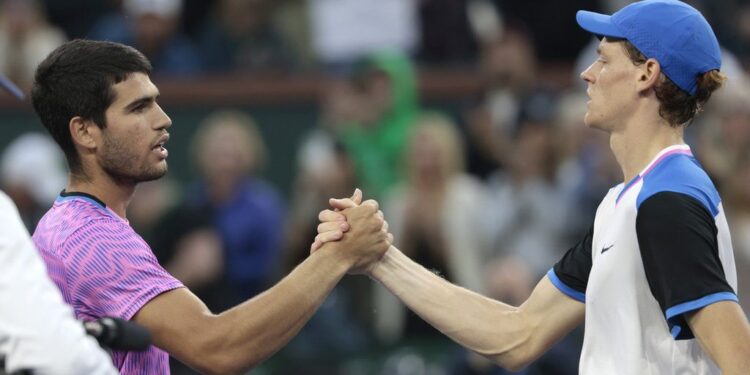Alcaraz and Sinner Show Big 3 Magic at Slams
Over the last 20 years, the tallest order in tennis, and maybe in all of sports, has been trying to rise to the challenge of facing Roger Federer, Rafael Nadal, and Novak Djokovic on a major stage. During that time, multiple generations of bright-eyed and highly touted young men have tried and failed to break the Big 3’s stranglehold on the Grand Slams and knock them off the rankings mountaintop.
The first group to take their shot included Grigor Dimitrov, Marin Cilic, Milos Raonic, Juan Martin del Potro, and Kei Nishikori. Together this cohort, who were correctly dubbed the “Lost Boys” early one, and who are now well into their 30s, eked out two major titles (one by Del Potro, one by Cilic).
The second crew to come at the kings included Daniil Medvedev, Alexander Zverev, Dominic Thiem, Stefanos Tsitsipas, Andrey Rublev, and Matteo Berrettini. The ATP optimistically labeled this group, who are now in their late-20s, the “Next Gen.” While they have risen higher in the rankings than their predecessors, they’ve also managed just two Slam wins (one by Thiem, one by Medvedev).
All of these players have top-tier talent. But when they went up against the Big 3, they were facing more than just a set of well-honed serves and forehands. They also had to contend with their aura, their mythic status, their living-legend reputations. How does someone with no Slam titles convince himself he can beat someone with 20 or more in a best-of-five-set match? Usually, he doesn’t.
Now a third generation is trying to grab tennis’s most elusive baton. So far it consists of just two members: 22-year-old Jannik Sinner, and 21-year-old Carlos Alcaraz of Spain.
The Italian and the Spaniard are starting their careers with one distinct advantage over their predecessors: The Big 3 are mostly out of the way. Federer retired before he could play either Alcaraz or Sinner. While Nadal is 5-1 against them, his career may soon be over, too. Djokovic carries on, but he’s 37 and hasn’t won a title in 2024. Alcaraz and Sinner have both beaten him at a Slam within the last 12 months.
As Wimbledon approaches, can we finally say that the men’s game has found its heirs to the Rafa-Roger-Novak throne? Alcaraz and Sinner have all the tools and weapons. The former combines electric ball-striking and movement, with a complete array of shots. The latter blends weighty power and consistency from both wings with a precociously cool head under pressure. But it’s what Sinner and Alcaraz did at the first two Slams of 2024—who they beat in the finals, and how they beat them—that may be the best reason to believe they’re the ones who will bring the Big 3’s legacy into the future.
At the Australian Open, Sinner was the solid favorite to beat Daniil Medvedev in the final, even though it was his first trip to a Grand Slam title match. Sinner had just beaten Djokovic, while Medvedev had staggered his way through three five-setters. In the final, though, the Russian jumped on Sinner with an all-out attack, and ran out to a two-set lead. That’s when Sinner showed just how deep his self-belief was by regrouping, adjusting, and taking command over the final three sets. In the ultimate crunch-time moment, at match point in the fifth set, Sinner fired a perfect forehand that touched down just inside the baseline for the win.
At Roland Garros, it was Alcaraz’s turn to face a member of the Next Gen, Alexander Zverev, in the final. Like Sinner, Alcaraz fell behind; in his case, two sets to one. But also like Sinner, once his back was to the wall, Alcaraz relaxed, shrugged off his earlier frustrations, and elevated his game to a place where Zverev couldn’t follow. He won the last two sets 6-1, 6-2, and, again like Sinner, closed with a blistering forehand.
Do those victories, and the way they were won, sound familiar? The ability to take a punch, to shrug off mid-match frustration, to grow calmer as the match grows tenser, to create your own winners when you need them. That’s the way Big 3 handled the big stage, and that’s the way Alcaraz and Sinner did, too. When it came to down to one set for the title, they were clearly better than their Next Gen opponents.
This doesn’t mean Alcaraz and Sinner will win virtually every Slam that comes down the pike, or dominate the game for the next 15 years, the way Rafa, Roger, and Novak did. There are some aspects of the Big 3 legacy that no mortal should be asked to match. It also doesn’t mean that the Next Gen crew will never win another big event.
But it does mean that Alcaraz and Sinner have that something special, that something extra, that makes contenders into champions. And it means the Big 3 has finally found a Big 2 who can take their baton and run with it.
















